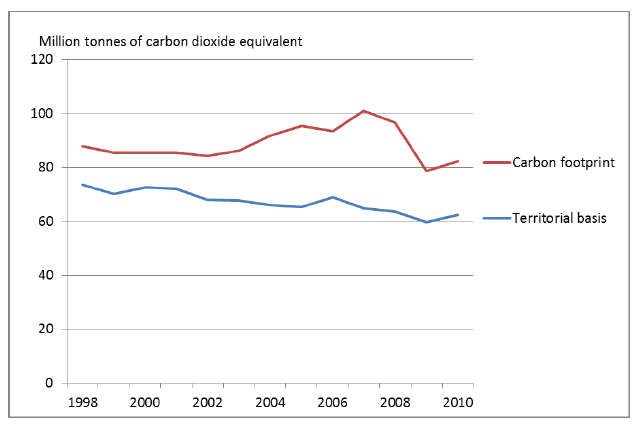Scotland's Carbon Footprint 1998 - 2010
This publication provides estimates of Scotland’s greenhouse gas emissions on a consumption basis; that is emissions that are associated with the spending of Scottish residents on goods and services, wherever in the world these emissions arise together with emissions directly generated by Scottish households.
Relationship with territorial emissions
Scotland's carbon emissions are measured in different ways for different purposes. Each basis of measurement is published by the government. The different bases should be viewed as complementary ways of accounting for carbon emissions.
Territorial basis
Emission estimates are published on the NAEI website on behalf of the Scottish Government, the Department for Energy and Climate Change (DECC), the Welsh Assembly Government and the department of Environment for Northern Ireland in the report "Greenhouse gas inventories for England, Scotland, Wales and Northern Ireland". This is a disaggregation of the UK inventory which is used as the basis for reporting UK emissions to the EC and United Nations Framework Convention on Climate Change (UNFCCC). The figures for Scotland form the basis for reporting on progress towards our domestic reduction targets. The Scottish GHG inventory measures emissions on a territorial basis, so only includes emissions which occur within Scottish borders, though it also includes estimates of GHG emissions emitted from international aviation and shipping based on Scotland's share of fuel sales from aviation and marine bunkers. The inventory also includes emissions and removals resulting from land use, land use change and forestry. Since these are not accounted for in the carbon footprint they have been subtracted from the territorial emissions in the comparison.
Figure 4 Relationship of a consumption measure of Scotland's GHG emissions with a territorial basis: 1998 to 2010

Figure 4 shows the relationship between the two different measures of GHG emissions relating to Scotland. The carbon footprint is notably biggest due to the impact of embedded emissions from imports. Whilst the carbon footprint has fallen by 6 per cent over the time period, comparable emissions on a territorial basis have decreased by 15 per cent. These contrasting trends may be due to the UK economy further moving from a manufacturing base to a service base with a greater dependence upon imports and their associated embedded emissions.
Contact
Email: John Landrock
There is a problem
Thanks for your feedback